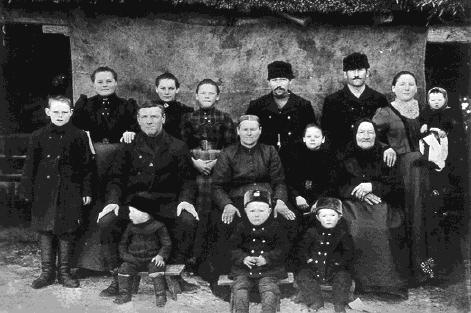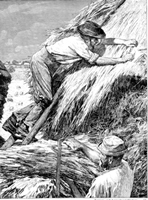Last Updated: 21 June 2002

Roofs and Things
![]() That Bump In The
Night
That Bump In The
Night
![]()
In a message dated 6/11/03 1:15:21 PM, RemMick@aol.com writes:
<< Roofs were made of wood beams [I assume] then were covered with thatch [reeds or straw], or tile. If made ofthe reeds were the reeds from the near by river beds? Limans? If tile, what was it laid over? Thin boards? Planks?
Someone mentioned critters lived in the thatched roofs. Insects? Lice? Snakes? Rats? Mice?
I remember reading a book about Vietnam where the soldiers brought in gas stoves but the villagers didn't use them. This upset the Americans because they couldn't understand why the villagers would want to cook over an open fire
.... The author explained that when the villagers used the gas stoves all the critters came to live in their thatched huts but when they returned to using the old fashion open fire with it's smoke the critters moved out.....
![]()

Thatched roof house with plastered walls over adobe brick in Borodino/Bess. S. Russia.
From Christine, nee Schweikert, Hein Collection
![]()
 See Johann
Schweikert's home in Crimea where he migrated and settled for a time before
migrating to Kulm / N.
Dak., USA. The home held a thatched roof. Before he
lived in the Crimea, he lived in Borodino / Bess. S. Russia.
See Johann
Schweikert's home in Crimea where he migrated and settled for a time before
migrating to Kulm / N.
Dak., USA. The home held a thatched roof. Before he
lived in the Crimea, he lived in Borodino / Bess. S. Russia.
![]()
In a message dated 6/12/03 8:19:58 AM, dougy@ruraltel.net writes:
<< I always was of the impression that things that fall in the night out of thatched roofs is why the canopy over the bed was invented.
Doug >>
![]()
Judy's NOTES: I think the common bed areas were canopy but not fancy but more like a box like the one shown below. The drapery's material may be heavy for winter and lighter weight for summer.
Peasant's Bed
Remmick-Hubert Collection
Click on photo and see larger image
A similar kind of bed with fancy lace curtains is seen in one of the photographs I have of my great grandfather's, Frederick Hoffer's, brother, Jacob Hoffer.
The wealthier the family was, the more money was paid for a bed. The same can be for today. Some of go out and spend as little as possible and others spend thousands.
I remember reading some data where some of the children slept on the deep ledges of the large fireplace so they could stay warm during the cold winter nights.
My great grandmother, Christine, nee Stehr, Hein spent a month's profit of wine sales to pay for a hand carved bed with the initials W.G.W.. [Do not know if the it was a canopy bed.].
![]()
In a message dated 6/12/03 1:01:02 PM, RWheelerst writes:
<< I doubt that GR's used canopied beds and I suspect that most ceilings in GR homes were not open to the thatch. I also suspect that thatched roofs were replaced with tiles as soon as possible as tiles were more permanent. One of my ancestral villages was Alt Danzig, founded in 1786 and I have a photo of the houses there roofed with thatch.
The comment that Doug made sparked my recalling a visit to a replica of Anne Hathaway's cottage and what the tour guide told of vermin often falling into beds in the houses with thatched roofs, resulting in the creation of the bed canopy. There were also drapes drawn around the bed to keep the cold out of the bed chamber.
Curt. >>
![]()
Lillian, nee Hein, Remmick: My Father's family had tile roofs. I believe the tile was made in Borodino. I remember my mother saying that when people ordered the building of their home, they asked the local craftsman to do so. This included the bricks for the wall, tile for the roof but the lumber had to be carried to Borodino by wagon. When the early colonists first arrived there were many wooded areas from which wood was cut and used. But, as the years past, colonists had to go farther and farther away from Borodino for their timber.... As I've said they had wood flours accept in the winter and summer kitchens. I think the building where the hired help and the Hein boys lived after they turned twelve probably had a hard dirt floor created as I've stated when asked about dirt floors. The Schweikerts and my Mother's family were not as well-to-do as the Heins. They were farmers and blacksmiths. Some of the Schweikerts lived in thatched roof houses..... I think the walls, fireplace and chimney were of the adobe brick. I don't think the thatch was seen from inside. I may be wrong. I don't recall Mother ever mentioning problems with rat, mice or bugs. But then, her family were true believers that "cleanliness was next to Godliness". Two story homes were rare. I believe the Bippus had a two story near the old church...
Ed: They must have had beams with thin boards to make the ceiling under the thatch which was so thick that rain ran right off....
Lillian: Mother talked about how the thatch had to extend over the edge to protect the exterior walls of a house and building. And, each year in Borodino it was required to patch and mend the walls and then white wash the exterior..... Thatched roofs last a few years...... [Lillian was not sure how many years a well made thatched roof lasted]. I remember some of the old sod huts that seem part of a hill side. Sometimes, grass would grow on those old thatched roofs. I remember hearing about a cow munching the grass on old Mr. _______ house. When the Mrs. tried to shoo it off, the cow fell through the roof and into the house. Fortunately, the cow wasn't seriously injured. [Lillian laughed at the memory.]
Ed Remmick: I think Grandpa [Friederick] Hoffer, his brothers and some neighbors built the first Evangelical sod church near Tappen, ND because their wasn't a home large enough for the growing population. I think there was a photograph of it in the newspaper ..... a long time ago.
Lillian: I do remember, in Borodino if a crane built it's next on a person chimney, that was a sign that the family would have good luck through the year. The cranes didn't like the metal roofs.
Judy: Tin?
Lillian: I don't know.
Ed: Probably, corrugated tin like I have on the goat barn.
Judy: Maybe iron?
Lillian: Around the older houses that were in the center of town were five foot walls, which were made of adobe bricks, plastered with limestone and then white washed. I think they were a couple of feet thick. Remember the rabbit story? It couldn't escape.....
Judy: Was the home and the barn attached?
Lillian: The Hein house, which had been purchased from the Braun family, was completely away from the barn which was huge...... There were also the stable for the horses..... The house my Mother was born in was not attached to the barneither. Her farmer wasn't a farm. Her father's blacksmith shop was huge and had belonged to his father [Jacob Schweikert] before he migrated to the Crimea.... It was about 1890 Grandpa Karl Schweikert sold his shop to _______ and migrated to the Crimea. But, he didn't like it. He missed Borodino and returned. Karl bought property that butted up against the wall of Grandfather Michael Hein, who owned the largest residence plot #393 plus other plots which he gave to his sons when they were married.

I've learned that there are different kinds of thatched roofs. There were reeds, different wild grasses and some used oats, wheat , or flax straw. The Thatcher, was the man who created the roofs, preferred winter straw which wasn't as brittle as the summer straw. He, also, preferred straw that had not been through a machine. The hand cut stalks were about the same lenght and in good condition to work.
If the weather was to be windy or subjected to strong storms, the thatch had to be secured with twine / ropes and stitched down on the rafters and even weighted if necessary.
The thatch had to overhang the wall to prevent erosion of the walls. If a leak appeared, there would be a streak of moisture down the wall that turned moldy green..... If the leak was not mended, the adobe would wear away....

Men Using Straw To Thatch Roof |
The Thatcher's tools varied and he could have in his locker one
or all of the following items:
|
Laice work under the roof which the Thatcher ties the straw to keep it in place |
There isn't a layer of wood under the thatch. It is a latice work of boards that are set about three feet apart...... Therefore, the ceiling inside isn't covered and a person can see the latice work of boards and center beam and the straw.
I don't know what kind of critters bred in the thatch. I presume there were critters.
Tile was made with clay and fired in kilns in certain communities and then carried by wagon to the villages. I assume the price varied and depended upon the distance between a tile maker / factory and the village. From reviewing photographs, it appears the tile are either flat or rippled squares. I presume that the title was placed on some kind of wood ...... Today we use thick plyboard. I suspect they used thin cross boards with sturdy cross timber as support.
Judy's Notes: (1) You can see a photograph of Karl Schweikert plow and wagon shop, which has a tile roof, in the book called Heimatbuch Borodino und Friedrichsfeld by Ernst Hoeger, a cousin, on p. 307. I think the shop was later owned by a Bippus cousin; (2) You can see several of the Bippus houses in the old photograph of the Lutheran Church which were near Karl Schweikert's house and shop....
When we were in Germany there were still homes and barns with thatched roofs. They were well kept for historical value as well as being interesting to tourists.
Thatched roof homes and barns. A village near Triberg / Ba.-Wu.
Remmick-Hubert Collection
1991
Click on photo to see larger image

Pfaff Index. Page |
Hubert Home Site |

|
|